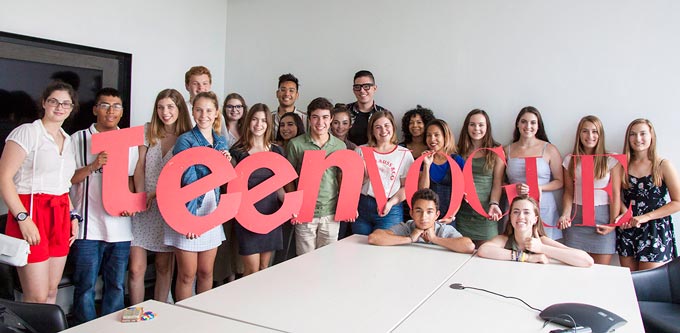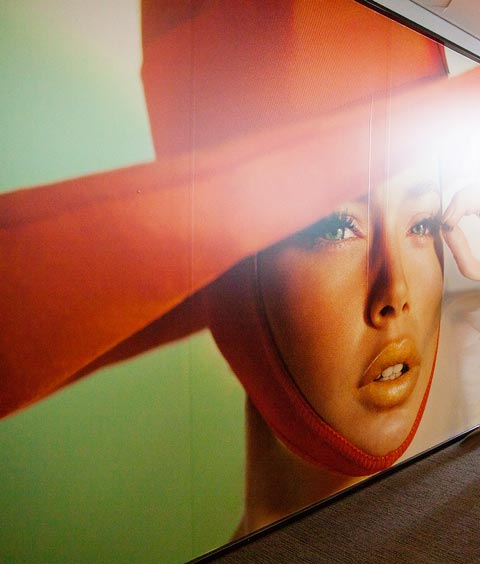INTERVIEW - August, 2018
FastForward Visits Teen Vogue
FastForward speaks with the creative staff at Teen Vogue
WRITERS: C.C. Clark, Sabine Lloyd, Lauren and Claire McKechnie, Samantha Michaels, Lily Baldwin
REPORTERS: Kylar Flynn, Kyle Austin, Brandon Lopez, Simone Harper, Angie Gonzalez, Jacqui Martin, Campbell Slavin, Josh Santos, Anna Silverman and Lilli Wanninger
S ince its founding in 2003, Teen Vogue has been one of the top teen fashion magazines; and as a young fan I would scour its glossy pages for all the fashion, hair, and makeup tips. A few years back, for whatever reason, I drifted away from the magazine, and it wasn’t until earlier this year—a few months after its final print edition—that the publication regained my attention through its online presence.
ince its founding in 2003, Teen Vogue has been one of the top teen fashion magazines; and as a young fan I would scour its glossy pages for all the fashion, hair, and makeup tips. A few years back, for whatever reason, I drifted away from the magazine, and it wasn’t until earlier this year—a few months after its final print edition—that the publication regained my attention through its online presence.
It was around the time of the Parkland shootings and I read an article that compared stories that typically run in Vogue and Teen Vogue. While the Vogue pieces tended to focus on seasonal trends and fashion weeks around the globe, the Teen Vogue articles weren’t concerned only with beauty tips. In addition, they were reporting on current affairs (like gun control) in a way that catered to—and didn’t patronize—a younger generation.
I’ve followed TeenVogue online ever since. The magazine explores politics and social issues with a frankness that inspires and respects its readers—an up-and-coming generation, many who have great hopes of changing the world.
We sat down in a conference room in the Condé Nast Building at One World Trade Center in Lower Manhattan with the creative staff who make Teen Vogue happen—executive editor Samhita Mukhopadhyay, entertainment features editor Gabe Bergado, wellness news editor Brittany McNamara, lifestyle editor Hannah Howard, and executive producer for video Amber Payne. Our top-of-mind topic was the magazine’s shift from 24/7 beauty and fashion to hard-hitting coverage of social issues.
It happened, Mukhopadhyay said, because the things Teen Vogue’s readership cared about started to shift.
“Teen Vogue has always been a fashion and pop culture brand,” she said. “We’re in a historical and cultural moment where people care about fashion, they care about pop culture, they care about Riverdale, but they also care about Trump. They care about what’s happening, the policies and people that are impacting their lives. And so it’s been a really exciting pivot within a brand that’s historically been defined by beauty and fashion and all these exciting things that we also all love as well, but to have an audience the way Teen Vogue does and actually engage them around these more purpose-driven and impact-driven narratives.
“Teen Vogue was kind of faced with its relevance in the modern world…The outlets that are really sticking out right now are the ones that are actually listening to their audience in an effective way and are becoming more relevant.”
Recognizing youth has its finger on the pulse and there was no media outlet speaking to us as equals, giving us facts versus opinions, Teen Vogue tapped into a voice that was meaningful.
Mukhopadhyay, who became the new executive editor earlier this year, has a background in developing diverse newsrooms. She said that when you elevate voices that are left out, “you start to see a change in how stories are told and you start to have more robust stories being told.” She believes that historically there’s been plenty lacking in how women, people of color, young people, and other diverse communities have been covered in the media.

Introducing politics into the pages of Teen Vogue was, of course, potentially explosive, carrying the risk of alienating advertisers, readers, even celebrities associated with the publication. But it was a risk the magazine had to take.
Mukhopadhyay, who’s spent the past 10 years covering politics and the White House, knows as well as anyone that we’re living through one of the craziest periods in recent history. Young people are frustrated and confused and need the facts and information to decide what it is they believe in and how to fight for it. Most media outlets aren’t catering to the needs of this young and politically engaged demographic, so Teen Vogue made it a goal to do so.
The transition didn’t happen overnight. At first the magazine’s political coverage was sparse, yet solid and reliable, so when people began to notice its emergence as a relatively political publication, Teen Vogue had already published plenty of substantial and thoroughly fact-checked political pieces so its credibility wouldn’t come under fire.
As Howard put it, “People will question your credibility, especially when you have ‘Teen’ in your name. I’m sure a lot of you know that it’s hard to be taken seriously when you’re a young person, and just having the basis to say ‘We’ve done X, Y, and Z, and you can come after any of these things because we know they’re solid’—that is a really big [deal].”
Of course, Teen Vogue hasn’t gone completely political—it still covers the latest trends in fashion and pop culture. This is one place where you can be crafting a timeline of Hailey Baldwin and Justin Bieber’s relationship one moment and covering the Syrian refugee crisis the next. That a young women’s magazine is covering social and political issues has been generating a lot of attention, but “Women’s magazines have actually been covering politics for a while,” said Mukhopadhyay, “and women have been leading the charge for women’s magazines to have better coverage for a while.”
Teen Vogue even combines fashion and politics in individual pieces, as in its story on model Halima Aden.
“We covered her returning to the refugee camp that she was born in and lived in for the first seven years of her life,” said Payne, “so it was a way to do a story that had an element of fashion and profiling someone who is high profile and celebrity but also bringing in a lot of issues that are really important to talk about right now around immigration, around the Muslim travel ban, just around politics.”
As it’s become a more political magazine, Teen Vogue has focused more on wellness and inner health and moved away from featuring only models with “perfect” (but not necessarily healthy) bodies. Now, instead, models are of all different body sizes, races, and genders, so hopefully teen girls won’t compare themselves unhappily to the glossy supermodels they usually see in magazines.
“We don’t all look the same,” said McNamara. “We all come from different backgrounds, we want to see ourselves in the media too, so it’s something that’s at the top of our minds because of our personal experience and because we know that’s what our audience wants too.”
Despite all the change, Teen Vogue’s mission hasn’t changed. Providing accurate and useful information to its audience is of utmost importance. (Teen Vogue has a copy research department dedicated to accuracy and fact checking.) So is entertaining and educating the readership in an inclusive and respectful manner.
“It’s to just educate and inform and entertain—that’s the duality here. Our audience is meeting you where you are and it’s exactly where we are. That’s why we have these voting guides and things like that, because we’re getting 18-year-olds who are new to the polls. So the mission is to be accurate. It is to be inclusive. It is to educate.”
Stories We Loved and Learned from  Staff
Staff
Brittany McNamara:
I did an article about homelessness and periods and basically how periods can exacerbate homelessness, and for people experiencing homelessness it can literally be a choice between buying a meal or buying Tampons. I think it’s something most of us don’t think about. I interviewed young women who had been homeless who talked about what it was like for them to be living in a shelter experiencing poverty and not being able to access the products that they needed; it was eye-opening. It’s something that happens every month and we don’t think about it. We were able to shed light on something that’s not super talked about and it was really meaningful for me to talk to these people and to be able to amplify that story.
Amber Payne:
For me, it was our Parkland coverage. We had a lot of great video, but the one that stands out to me was the students reading text messages from mass shooting victims. It was a chilling video. You read the stories of the texts that someone was sending to their mom or to their boyfriend and they don’t know if they’re going to make it. Some of them made it and some of them didn’t. We very editorially examined a lot of the school shootings most recently over the last ten years, and then we found a cast of students that we assembled which also was very diverse. One of them was the woman from Newtown who lost her brother. There was a Ferguson High School student who is an activist who was very involved in the Black Lives Matter movement. A woman who led a walkout in her St. Louis school. A Native American woman from Wyoming whose family are gun owners but she’s very active on gun reform. And a Howard University student. We had a great collection of students who had very different backgrounds. It was very intersectional. It was very diverse. But the fact that they were reading these text messages in this high school, it was just a very emotional day. It was a very emotional shoot.
Gabe Bergado:
For a “Young Hollywood” shoot earlier this year, it was our first digital cover so we had eight different up-and-coming actresses talking about making it, the projects they’re on. I got to interview Awkwafina, who was in "Crazy Rich Asians," and it was a frank conversation about navigating the world as an Asian in entertainment. She’s Asian, but she’s half Japanese/half Korean, and when you think about Asian, a lot of people don’t think past that. I’m half Mexican, half Filipino and we were talking about our dual identities. It was just one of those moments where it really reminded me why I love storytelling so much and why I love the platform of Teen Vogue because I’m able to bring these conversations that are important that might not necessarily have been told in mainstream publications yet.
Hannah Howard:
The most important things I think I’ve worked on are pieces written by students. We asked a student to talk to other students about what they think about Greek life shutting down. This spring there were some really horrifying videos of fraternity members at Syracuse saying awful racist and ableist things. We had had a student from Syracuse write about his fear of walking past fraternity row as a gay man. Some students wrote about what it’s like to be black at a predominantly white institution or what it’s like to be a transgender man at an all-women’s college. We’ve told really great stories from the perspective of the people who are living them, which I think is probably one of the most important parts of my job. I can talk about what’s going on at college campuses or at high schools as much as I want. I’m not going to know firsthand because I’m not in that situation anymore.